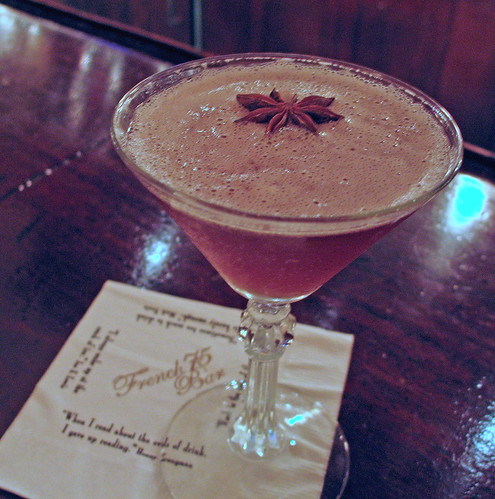Columbian Punch
If you’re going to throw a party, make punch.
[UPDATE: Those of you seeking great historical punch recipes (as well as the amazing history of punch) should check out David Wondrich’s indispensible Punch: The Delights (and Dangers) of the Flowing Bowl, published in 2010. The recipe has been revised slightly to include the technique of making “oleo-saccharum” as learned in this book.]
It’s easy, tasty (if you pick the right one), and you don’t have to spend all night mixing drinks for people. The key is finding the right punch. As our friend Dr. Cocktail points out in his excellent recent post on punches, simply go to CocktailDB, enter the word “punch” in the search box and you come up with 98 of them. I found even more looking through some of my old cocktail recipe books. Still, as interesting as many of them looked, I wasn’t exactly lighting up with excitement.
We had some folks over for a holiday party last night, and the punch was the talk of the living room. This is yet another of the pleasures of life for which we must thank Dr. Cocktail, who provided the recipe for the best punch I’ve ever had. Said punch recipe dates back to the early 19th Century and in 1893 was named “Columbian Punch” at the first world’s fair, the 1893 Columbian World Exposition in Chicago, which celebrated the near-quadricentennial (so they were a year late, big deal) of Columbus’ “discovery” of America (Natives: “Um, you can’t discover us, we already live here!” Columbus: “Do you have a flag?” Thank you, Eddie Izzard.).
I’ll research and attempt a few other punch recipes that looked interesting, but out of at least two dozen recipes I studied this week, none was as interesting as this. It’s fantastic. To this day it still rules as my favorite punch.
COLUMBIAN PUNCH
1 quart Jamaican rum.
1 pint brandy.
4 ounces Green Chartreuse.
1 pint freshly brewed oolong tea.
The juice of 2 lemons.
The juice of 2 oranges.
1 cup superfine sugar.
750ml Champagne.The day before making the punch, fill a metal bowl or large tupperware container (that fits into your punch bowl) with water and freeze to make a large block of ice. (Or, if you’re forgetful like me, you can always just buy block ice and break it down to fit your punch bowl.) Chill the boozy ingredients and tea; keep the fruit at room temperature.
Carefully peel the lemons and oranges, getting as little of the white pith as you can. Muddle the peels with the sugar until you’ve extracted as much citrus oil as you can from them, and allow to sit for at least an hour, preferably three hours. Juice the fruit and strain the juice.
Combine the boozes, juices and tea with the muddled peels and sugar in a large punch bowl and stir until dissolved. Remove the peels. Add the Champagne and stir, then add a large block of ice to keep chilled. Ladle into small punch glasses and allow your guests to serve themselves until it’s gone (and I guarantee you’ll have none left).
(Recipe originally published in Beverages and Sandwiches for Your Husband’s Friends, authorship credited only to “One Who Knows”, 1893.)
This is unbelievably good, and not for the faint-hearted either (i.e., it’s mostly booze). Rather than shriek, “J’accuse! You stole me idea, you young cur!”, Doc was, of course, gentleman that he is, flattered that I had made the punch; to the best of his knowledge no one other than himself had made this stuff in the last hundred years or so.
For the rum I used a fifth of Appleton Estate, topped off with some Myers’ Dark to make a quart. For the brandy I used Courvoisier VS, which was on sale for $19.99 for a 750ml, in a lovely gift box with two narrow brandy-and-soda glasses (such a deal).
You, of course, have a bottle of green Chartreuse in your bar (along with a bottle of the yello variety) because, although pricey, they last a long time and are indispensible for any number of truly extraordinary cocktails. Green Chartreuse makes an excellent post-prandial digestivo as well.






